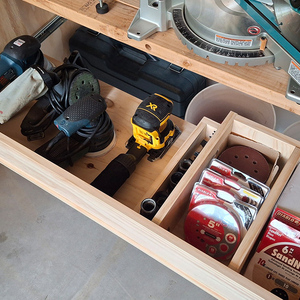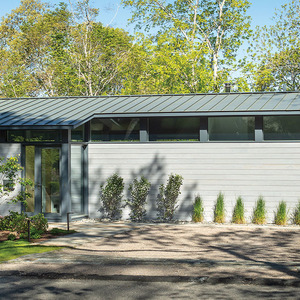I’m looking to buy a generator. At most, I’ll be running a pancake compressor, circular saw and Milwaukee radio at the same time.
Within the past week, I saw generators on sale from 299 to 999 and up.
Does anybody know how small I can go with the generator?
Thanks in advance.



















Replies
you can go as cheap as you want as long as it has a HONDA motor.
4000
Dollars?
Amps? er, watts?
I bid on a gov surplus generator that had a 4 cylinder engine, but only 6 hp.
Description said engine, but there was a generator hooked to it. Went for 325 bucks. Most of that stuff is shot and only for parts, but it looked nice. My bid topped out at $75. Original cost said 3200 bucks.
Edited 6/17/2006 11:32 pm ET by MarkH
huh?
To the 4000 answer from Mooney. I think he meant 4000 watts. He's been around a while and is practical so that's what I'd shoot for. If the generator is rated for the loads you need, you'll find that the starting current for a compressor or saw may cause a real problem, either the tool won't start, or the breaker will trip, or you might have a brownout type problem that can damage tools, as well as spiking on recover from overload which has been said to fry battery chargers.
I'm talking about just adding up the watts on the nameplate (amps x volts). That is normal operating watts, but you need to have more than the stated power available to cover starting power.
Forget the radio, it is not going to make a difference. The compressor will use about 1800 watts by itself, and the saw probably a little less.
Edited 6/18/2006 12:01 am ET by MarkH
4000 is the number of spares to have on hand if he buys a cheap one.
Whaaat? You got something against Coleman?
Very happy day when mine went to a new home...PAHS Designer/Builder- Bury it!
I'd be tempted to buy a good gas compressor instead of 4000 cheap generators.
?"I bid on a gov surplus generator that had a 4 cylinder engine, but only 6 hp."
As you may well know, the government grossly under-rates stuff like horsepower.
I used to work on those generators when I was in the Army. I'd absolutely love to have one, as they were reliable and almost indestructable.
Procrastinate now.
It was sweet looking, but I don't know what type generator it was. 28v? Had 3 analog gauges. Bore and stroke was 2" / cylinder. Had 2 big air cleaners. Wasn't beat up looking. Had a starter rope, but only a cup, no recoil. Located at the Wright Patterson AFB, about 4 miles away.
All the generators that size that I worked on were either 110/220 or 24V for charging batteries. I don't remember enough details about them to tell you how to tell 'em apart.
Q: How do you turn a fox into an elephant?
A: Marry her.
That's why I was leery of going over $75. 24 volt genset would be pretty useless to me.
hf,
Look at the ratings of the tools you think you will have running at the same time. Add up the total watts, then add a fudge factor for start up current, especially for the compressor, then get a generator that is sufficient to cover it all.
Bill Koustenis
Advanced Automotive Machine
Waldorf Md
Dumb question from a not too smart framer.... How do I find the watts my compressor and circ. saw and radio run?
sorry
4000watts
The reason I say this is because I own one and a nice one as its an Onan. 1800.00 new, but its very quiet and commercial. Also one heavy muther. Its not that big though.
It will run a pankake compressor but not a wheel bar . DW miter saw and table saw . Only one at a time . A charger and a radio is nothing to add to it . I would have thought it would have run them all but nope. It wont even start a wheelbar compressor with out killing it . Im glad I have a gasoline honda compressor to add with all that stuff cause the generator will run anything else including a joiner.
Tim
Thanks for the responses. I'm truly wiser now than I was a couple hours ago. BTW. I have to share. I peeked in the back of my wife's van and saw a new Stihl chainsaw she got me for fathers day. I can't wait to rip up some sh*t!
My next question is, what do I do when I don't have any trees left?Since lots of people leave quotes at the end of their posts, here's mine - perfect for those that are proud of doing something right....Even a stopped clock is right twice a day
My next question is, what do I do when I don't have any trees left?
No problem. I've got enough extra to keep you busy for a few yrs. You making lumber or firewood? Kevlar chaps are good. Don't forget the ear muffs.
Have fun.PAHS Designer/Builder- Bury it!
Watts is simply volts times amps. Since most tools are rated at 120 volts, you just need to figure the amps. Most tools have a small plate that gives the amps that the tools is expected to draw while on others it is molded into the plastic. If I remember correctly (which I probably don't) a sidewinder saw is about 13 amps, while a drill may be about 6 amps on up. A compressor of any size will likely run close to 15 amps or maybe up to almost 20. Radios generally don't draw that much, maybe two or three amps. Most generators are rated to allow a brief extra current draw during start up of the tool. However, I have found that in moderately priced generators, running near the maximum watts will bring down the voltage (most noticeably, any lights running off of the generator will dim). If you get a 4000 watt generator and have a 13 amp saw and a 15 amp compressor along with a 2 amp radio, then you are at 3600 watts with only a margin of 4 amps to run your 400 watt work light or whatever.
What MrBill said. Fudge factor on a compressor is usually three times the current draw on the motor at startup, or thereabouts. If you've got other things running off the generator when the compressor kicks in, make sure the generator has enough juice so you don't burn up any tool motors. At least that's what the generator repair guys around here tell me. And having a Honda motor on it makes it even better.
I like a 5000W generator for framing and agree whole-heartedly with those that suggest you really consider something with a Honda engine. Best bang for the buck, IMO. They're a little more money, but a much greater value when the day is done.
Just another little FYI...... electric compressors and portable generators are a poor match. I know guys do it all the time, but they ask an awful lot from the generator and even more from the compressor.... and that's if it'll even get the compressor through start-up. Winter time makes things even worse.
I've got a 6000W Wacker generator with a Honda engine. With a couple saws running, a twin stack compressor kicking on is enough to ensure that none of the tools are getting the proper amount of juice. You can hear the change in pitch in the saws and the compressor makes it pretty obvious that it's struggling. That particular arrangement lasted less than a day for me before we pulled the gas compressor out of the trailer and fired that up too.
Strongly consider a generator with a 'low idle' option as well. You'll save a ton of gas by having the generator idle down when you're not actually drawing power. My Milwaukee jobsite radio doesn't draw enough juice to kick up the idle, so it works out nicely. Pull the trigger on the saw and you've got about a 1/2 seconds hesitation before you can cut, but you get used to it really quick.
My experience with generators is that you really do get what you pay for. For a small framing crew (up to maybe four guys) I'd stick in the 4000W (min) to 6000W range and look to spend a min of around a $1000. I've had very bad luck with the stuff at the Big Boxes like Coleman and Generac and everything with a B&S or Tecumpseh engine. I've had good luck with everything with Honda engines, Yamaha generators, and I've heard that the Kohler and Onan engines are very very good as well.
For equal money, I'd buy a good used generator with a Honda engine before I spend the same money on a brand-new homeowner job.
Great post, Brian, and right on target.
What DP said.
"Citius, Altius, Fortius"
> With a couple saws running, a twin stack compressor kicking on is enough to ensure that none of the tools are getting the proper amount of juice.
This is a starting surge issue. One solution would be to put a really big flywheel on the generator. Probably not done because it's hard to explain to customers why this is a good feature.
-- J.S.
Hey happyframer,
The best source for info on getting the correct type and size generator that I have come across is the "generator buying guide" from Northern Tools.
It gives all the information you have been reading here yet is more concise and gives exact requirements to meet specific energy magnitude requirements for specific types of equipment.
If you are going to get a generator read this first. If I would have read this it would have saved me from buying the wrong compressor the first two times I got one (Hey-sometimes I'm a slow learner) :0)
You're doing the right thing in finding out what you're getting into before buying. This way you know what the equipment will do and what it won't do. Don't be like me and buy a compressor before reading this guide.
Have a good one,
Cork in Chicago
http://www.northerntool.com/catalog/buyersguides/generators/